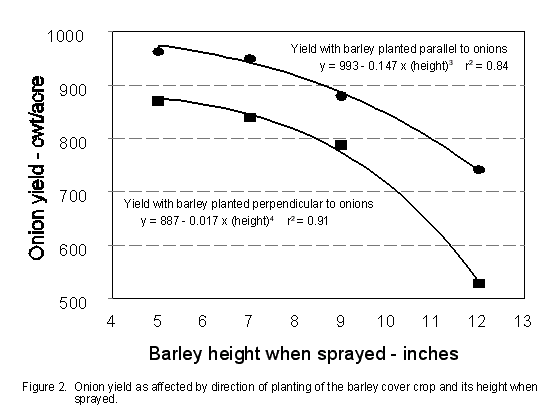
Oakes Irrigation Research
Site
Carrington Research Extension Center * North Dakota State University
P.O. Box 531, Oakes, ND 58474-0531, Voice: (701) 742-2189, FAX: (701)
742-2700, email: rgreenla@ndsuext.nodak.edu
ONION COVER CROP STUDY, 1996
Richard G Greenland
High winds, which occur frequently in the spring time in North Dakota, blow soil particles from the finely prepared onion seedbed across the ground, causing extensive damage to newly emerged onion plants. One way of stopping the destruction is by planting a cover crop. In this study a cover crop of barley was drilled just before the onions were planted. Onions were planted either perpendicular to or parallel with the rows of barley. The barley was then killed with Fusilade at different heights and data collected to determine the effect of the cover crop on onion production.
MATERIALS AND METHODS
| Soil: | Maddock sandy loam; pH=7.5; 2.4% organic matter; soil-P was medium; soil-K was high; soil-S was very low. |
| Previous crops: | 1995 - soybean; 1994 - carrot; 1993 - winter squash. |
| Seedbed preparation: | Disked twice on April 17. Multiweeded (field cultivated) twice on April 18 to incorporate fertilizer and smooth the seedbed. |
| Planting: | Drilled barley cover crop on April 18 (1 bu/acre, 7-inch rows). Direct seeded 'Santos' or 'Oro Grande' (1/2 of study to each hybrid) onions on April 18 with a Stanhay vegetable planter at a population of about 200,000 seeds/acre. Planted in paired rows (3" apart), with the paired rows on 14" centers. |
| Plots: | Plots were 56 inches (four paired rows) wide by 17 ft long. The study had 4 reps. |
| Fertilizer: | On April 17, broadcast 14 lbs N/acre and 70 lbs P2O5/acre as 10-50-0, 16 lbs N/acre and 19 lbs S/acre as 21-0-0-24, and 94 lbs K20/acre as 0-0-60. Sprayed 18 lbs N/acre as 28-0-0 on April 17. Side dressed with urea twice: 70 lbs N/acre on June 19; and 50 lbs N/acre on July 9. |
| Irrigation: | Overhead sprinkler irrigation as needed. |
| Pest control: | Weeds were controlled with: Dacthal (8 lbs/acre) on May 6 (which was preemergence to onions but post emergence to barley), Buctril and Goal (1 pt and 0.6 pt/acre on June 7), Buctril and Goal (0.5 pt and 0.3 pt/acre on July 2), and Fusilade + Penetrate II (1 pt/acre + 1 pt/25 gal). No insect control needed. |
| Harvest: | Pulled onions on Sept 16. Onions were allowed to dry in the field until about the middle of October, when they were bagged. The tops were removed and onions graded on Nov. 27. |
Return to top of onion cover crop study

Return to top of onion cover crop study
RESULTS
The results of this study confirm the results of studies in 1994 and 1995. As shown in figure 2, onion yield decreased as barley height increased. However, onion yield when barley was killed at 7 inches was not significantly different from onion yield when barley was sprayed at 5 inches. This was true for either perpendicular or parallel planting of the barley cover crop. Onions yielded more when onions were planted parallel to and between the barley cover crop rows than when the onions were planted perpendicular to the barley rows. This was probably due to less competition from the barley and/or better protection from the wind. When planting parallel, onion rows were always planted in between the barley rows. If the onions had been planted parallel with the barley and in the barley row, the competition from the barley would have been greater and onion yield would probably have been reduced. Our recommendation is to plant the onions parallel with and in between the rows of the barley cover crop. The barley cover crop should be killed when it is 6 to 8 inches tall.
Return to top of onion cover crop study
Go to Oakes Irrigation Research Site Cover Crop Studies page
Go to Oakes Irrigation Research Site 1996 annual report